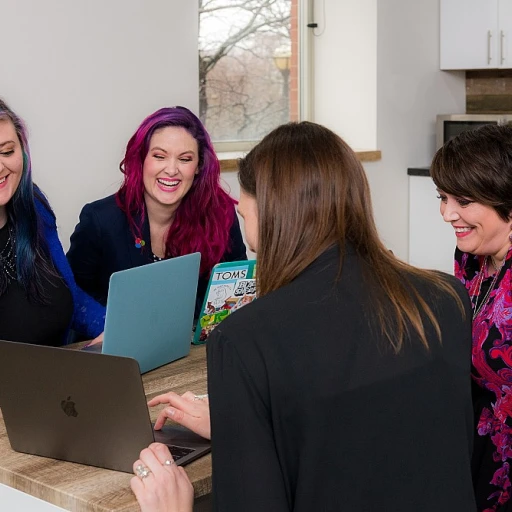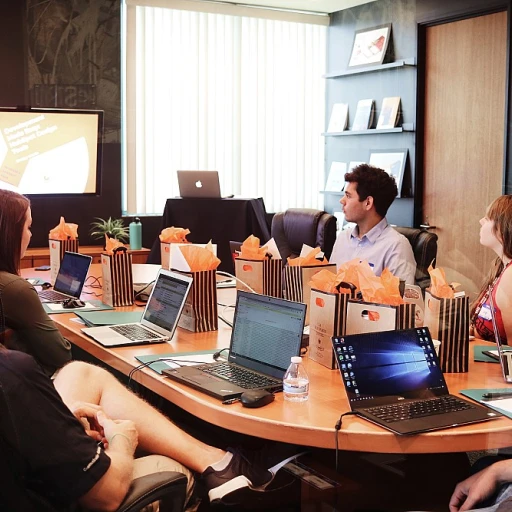Understanding the Role of Team Meetings in Employee Engagement
Team meetings play a pivotal role in shaping employee engagement, serving as a crucial platform for communication and collaboration. When organized effectively, they can significantly enhance the morale and productivity of a team. Understanding the role of these meetings in boosting engagement involves recognizing their potential to foster connection among team members, provide transparency about projects, and offer opportunities for meaningful feedback.
The Foundation of Engagement
Teams rely on effective meetings to keep the lines of communication open. By offering structured time for teams to meet, share updates, and address any challenges, meetings ensure alignment on goals and expectations. This alignment helps to avoid misunderstandings and promotes a cohesive working environment, which is essential for engagement.
Creating a Conducive Environment
To engage your team fully, it's important to foster an environment where every member feels heard and valued. One way to kick off a meeting on a positive note is by incorporating ice breakers to create an inclusive atmosphere where participation feels effortless. Engaging your team with thoughtful ice breaker questions can pave the way for open dialogue and help break down barriers among team members.
Role of Structure and Clarity
The backbone of a successful team meeting is a well-crafted meeting agenda. It provides clarity and direction, ensuring that discussions remain focused and relevant. Agendas should clearly outline discussion topics, allocate time for each agenda item, and specify who is responsible for leading particular segments. This approach not only boosts productivity but also ensures that all voices are heard.
Encouraging Ongoing Feedback
Post-meeting feedback is an invaluable tool for improvement. Gathering insights from team members about what works and what doesn’t can help in refining the meeting structure. Such feedback serves as a guide to continually enhance meeting effectiveness and reinforce a culture of inclusion and engagement. By fostering this open exchange, teams can become more attuned to each other’s needs and preferences, which is fundamental for engagement.
Designing Effective Team Meetings
Crafting Meaningful Agendas
Developing a thoughtful meeting agenda is crucial in ensuring the team meetings are effective and engaging. A well-structured agenda lays the groundwork for productive discussions and keeps the team focused on the intended goals. Begin by clearly defining the objectives of the meeting, whether it's to discuss a new project, seek feedback, or simply a routine check-in. This sets the stage and helps in prioritizing topics based on their relevance and urgency.Time Management: Keeping Meetings On Track
Respecting the allocated meeting time is essential to foster a productive environment and demonstrate respect for team members' schedules. Start meetings on time and ensure that the discussions do not veer off track. This requires a delicate balance of allowing members to share their thoughts while keeping the conversation focused on the agenda. Implementing time blocks for each agenda item helps manage the flow of discussion and ensures all topics are covered without unnecessary delays.Engaging Participants and Promoting Collaboration
To create an effective team meeting, it’s important to actively engage all participants. Encourage participation by asking open-ended questions, welcoming different perspectives, and making space for everyone to voice their ideas. Facilitating inclusive conversations can help team members feel valued and motivated to contribute. Consider integrating engaging ice breakers as a way of warming up the room, as suggested in Engaging Conversations: Unlocking Team Potential with Effective Ice-Breakers. This can enhance team collaboration and produce more dynamic meetings.Setting Clear Action Items and Next Steps
An effective team meeting should conclude with a clear set of action items and next steps. This ensures that discussions are not just theoretical but lead to tangible outcomes. Assign responsibilities for each action item and establish deadlines to promote accountability. Keep track of these assignments using tools like meeting notes or project management software to maintain clarity and focus for the team.Using Feedback to Improve Future Meetings
Regular feedback from team members about the meetings can provide valuable insights. Gathering their thoughts on what worked well and what could be improved aids in refining future team meetings. This feedback loop allows leaders to adapt their strategies to meet the evolving needs of the team, ultimately boosting productivity and team effectiveness.The Impact of Virtual Team Meetings on Engagement
Adapting to Virtual Formats
As organizations increasingly embrace remote work, virtual meetings have become a staple in how teams communicate and collaborate. These virtual team meetings can significantly affect employee engagement, positively and negatively. Let's explore how you can make these virtual gatherings more effective and inclusive.
Firstly, the use of technology tools such as Microsoft Teams is pivotal in facilitating seamless communication. These platforms allow teams to hold meetings, share documents, and provide feedback efficiently, thus boosting productivity and collaboration. However, to reap the benefits, ensure all team members are familiar with the platform and comfortable using its features.
Additionally, setting a clear meeting agenda beforehand is crucial. This not only keeps the meeting focused but also respects the valuable time of team members by preventing unnecessary digressions. The agenda should include key discussion points, project updates, and action items that will be covered, ensuring everyone knows what to expect and how they can contribute.
Maintaining Engagement in a Virtual Environment
Maintaining engagement in a virtual setting requires creativity and dedication. Consider incorporating interactive elements such as polls or breakout sessions to make meetings more engaging. Encourage team members to share their insights and learn from each other, which can foster a sense of connection despite physical distances.
Moreover, scheduling consistent check-ins or weekly team meetings can keep the momentum going and provide regular opportunities for feedback. Regular meetings help team members stay aligned with the project's goals and maintain focus on collective objectives. Over time, this can cultivate a culture of trust and belonging, essential components of engagement.
Adopting Best Practices for Success
To overcome the challenges of virtual meetings, adhere to best practices. These may include setting a designated meeting time convenient for all participants and ensuring there's a person responsible for taking meeting notes. Documenting meeting outcomes and circulating them post-meeting helps reinforce key decisions and action items, keeping everyone accountable.
Finally, recognizing individual and team achievements during meetings can enhance morale and motivation. Celebrate successes, no matter how small, and use these opportunities to remind your team of their progress and contributions.
Encouraging Participation and Feedback
Fostering Active Participation and Honest Feedback
To enhance employee engagement during team meetings, encouraging active participation and honest feedback is paramount. Meetings that stimulate contributions from all members tend to be more effective and valuable for everyone involved.
Here are some ways to foster a participatory environment in your team meetings:
- Set Clear Agendas: Having a well-defined meeting agenda helps in guiding the discussion and ensures that all necessary topics are covered within the allocated time. Share the agenda in advance so team members can prepare their thoughts and inquiries.
- Rotate Meeting Roles: To make everyone feel valued and responsible, rotate roles such as note-taking, time-keeping, or leading the discussion. This not only helps in building diverse skills among team members but also increases their engagement.
- Encourage Open Dialogue: Cultivate a culture where team members feel comfortable voicing their ideas and opinions, even if they differ from the norm. Constructive discussions often lead to innovative solutions and enhanced collaboration.
- Implement Feedback Loops: After meetings, solicit feedback on their effectiveness, perhaps via a survey or a quick check-in. Incorporate this feedback into planning future meetings to continuously improve and adapt.
Achieving successful team collaboration requires more than just attending meetings. By actively seeking and valuing your team members' ideas, and implementing feedback mechanisms, you can build a workplace culture that prioritizes continuous learning and improvement.
Measuring the Success of Team Meetings
Assessing the Impact of Meetings on Employee Engagement
To determine the effectiveness of team meetings in enhancing employee engagement, it is crucial to establish a system for measuring their success. By evaluating certain key metrics, organizations can ensure that their meetings not only serve their intended purpose but also contribute positively to team morale and productivity. First, consider the overall productivity of the meetings. Evaluate whether the meetings adhere to the planned agenda and if team members are making progress on action items discussed. Frequent check-ins with team members can offer insights into how meeting time is being utilized. Feedback from team members plays a significant role in assessing the impact of meetings. Encourage team members to share their perspectives on what's working and what can be improved. This feedback will help refine meeting processes and make them more effective. Monitoring the participation levels during meetings can also highlight engagement levels. Effective team meetings should facilitate active interaction among participants. Teams should pay attention to whether all members are contributing, particularly in virtual meetings or when using platforms like Microsoft Teams. Another useful metric is the level of collaboration and team spirit fostered during meetings. Successful team meetings usually enhance team collaboration, which, in turn, boosts productivity and strengthens project management efforts. Utilizing tools like meeting notes or recording action items in project management software can provide a clear picture of how meetings align with business objectives. This systematic approach will ensure that meetings remain purposeful and contribute to achieving strategic goals. Finally, it’s important to continually learn and apply best practices for meetings. Keeping an eye on these factors and regularly reassessing them will help maintain a cycle of continuous improvement, ensuring that team meetings remain an effective tool for employee engagement.Overcoming Common Challenges in Team Meetings
Overcoming Challenges for Productive Meetings
Navigating the complexities of team meetings can be daunting, yet focusing on effective meeting practices can significantly enhance employee engagement. Here are some best practices to help overcome common challenges:- Time Management: One of the most prevalent challenges is managing meeting time efficiently. Establish a clear meeting agenda outlining all discussion topics and time allocations to ensure meetings are on track and cover all critical points.
- Engagement in Virtual Meetings: With the rise of virtual meetings, keeping team members engaged can be challenging. Utilizing interactive tools, like polls and breakout rooms available in platforms such as Microsoft Teams, will help sustain participants' attention and foster team collaboration.
- Encouraging Participation: Facilitate a culture where all team members feel comfortable sharing their insights. Implementing regular check-ins and structured feedback sessions can boost team participation and provide diverse perspectives.
- Clear Communication: Ensuring clear and concise communication is crucial. Use meeting notes to document key discussion points and assigned action items, ensuring everyone is aligned on project objectives.
- Consistent Feedback Loop: Gather feedback from team members on the effectiveness of each meeting. This practice not only opens the door for continuous improvement but also lets team members know their opinions are valued.
- Project Follow-up: A lack of follow-up can hinder the successful implementation of meeting decisions. Regular follow-ups on action items and project progress promote accountability and productivity.












